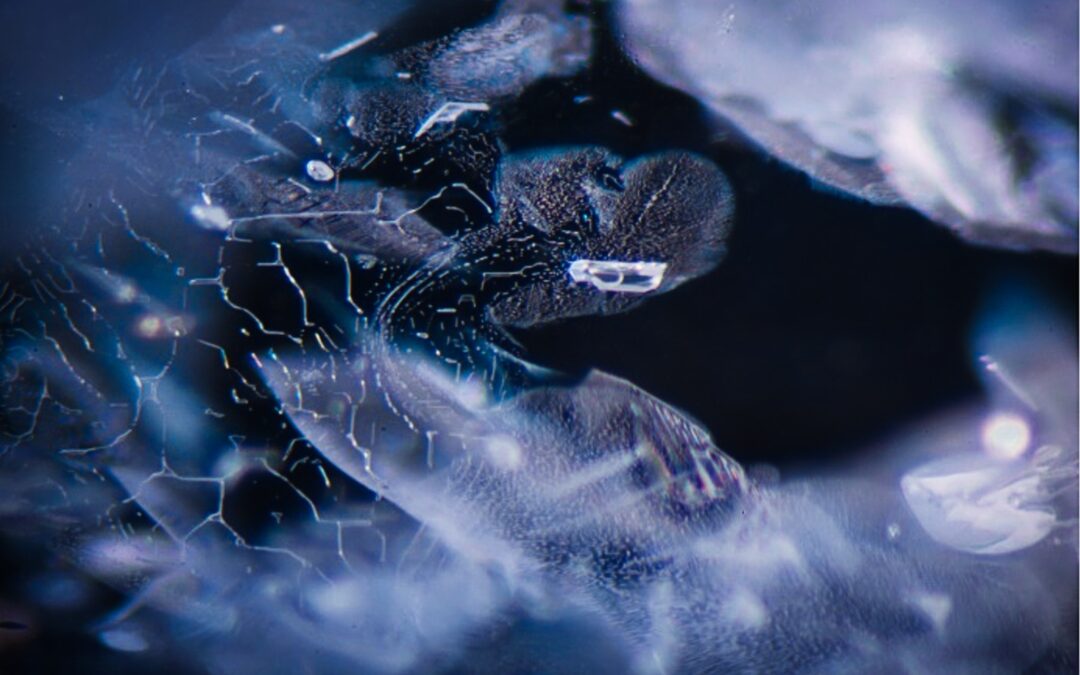Heat treatment is used to improve the colour and clarity of blue sapphires (Abraham,1982; Anonymous, 1917; Fryer, 1983; Koivula and Kammerling, 1991; Kyi et al., 1999;Nassau, 1982; Pemadasa and Danapala, 1994; Scarratt, 1981, 1983, 1985a, b, 1988;Themelis, 1992; Tombs, 1978; Tombs, 1982; Wijesuriya, 1985). Within this context,various similar and some dissimilar heat treatment techniques may be applied, withand without, the artificial addition of external elements. These treatments resultingin differing infrared absorbances and/or changes to the internal features observed following treatment.
This note focuses on four scenarios,
• “Normal” heating, ≈1,600˚C, (Nassau, 1982).
• The process originally applied by Punsiri Tennakoon and sometimes
known as ‘Punsiri’ heating (Punsiri, 2003; Scarratt, 2003).
• HTP (High temperature with pressure) (Choi H.M., 2014; Krzemnicki, 2019; Leelawatanasuk, 2016).
• Heating with the diffusion of beryllium (DuToit, 2009; Emmett et al., 2003; Scarratt, 2002a, b).
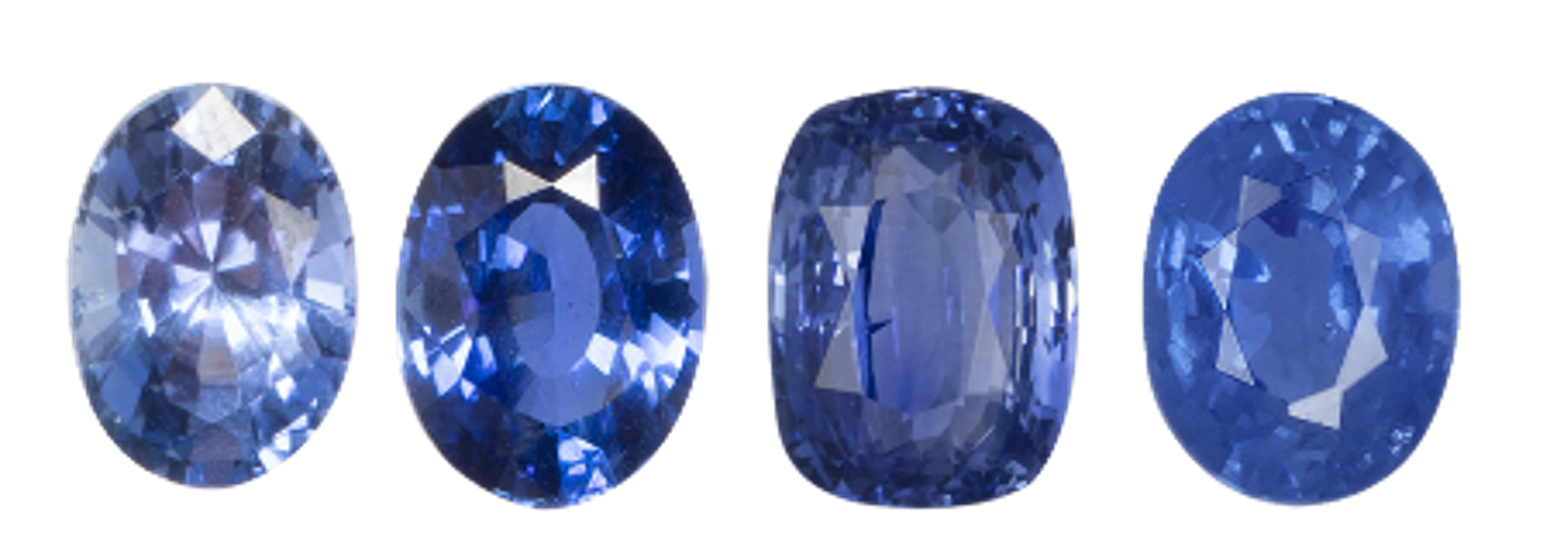
Figure 1
Blue sapphires treated by various methods, from left to right, “normal” heating, “Punsiri heating”, High temperature with pressure (HTP), and Beryllium (Be) diffusion.
Figure 1 depicts an example of each of these treated blue sapphires described above, each of which is of metamorphic origin. Below, in Figure 2, the FTIR spectra that recorded for each of these sapphires is detailed.
• The “Normal” heat treated stone records peaks at 3309, 3232 and
3185 cm-1.
• The “Punsiri heated” stone recorded a broad band at 3033, with peaks
at 2990 and 2626 cm-1.
• The HTP treated stone records bands centred at 3060 cm-1 with a
shoulder at 3130 cm-1 and peaks at 2626 and 2150 cm-1.
• The Be-diffusion treated stone records bands centred at 3060 and
2490 cm-1 (Balmer, 2015)
In addition to the FTIR data, each of these treatment techniques may on
occasions provide useful internal features for gemologists to use in the
identification process and examples of these are provided here in following images. Note that with Be diffusion it is recommended that the treatment is confirmed by LA-ICP-MS.
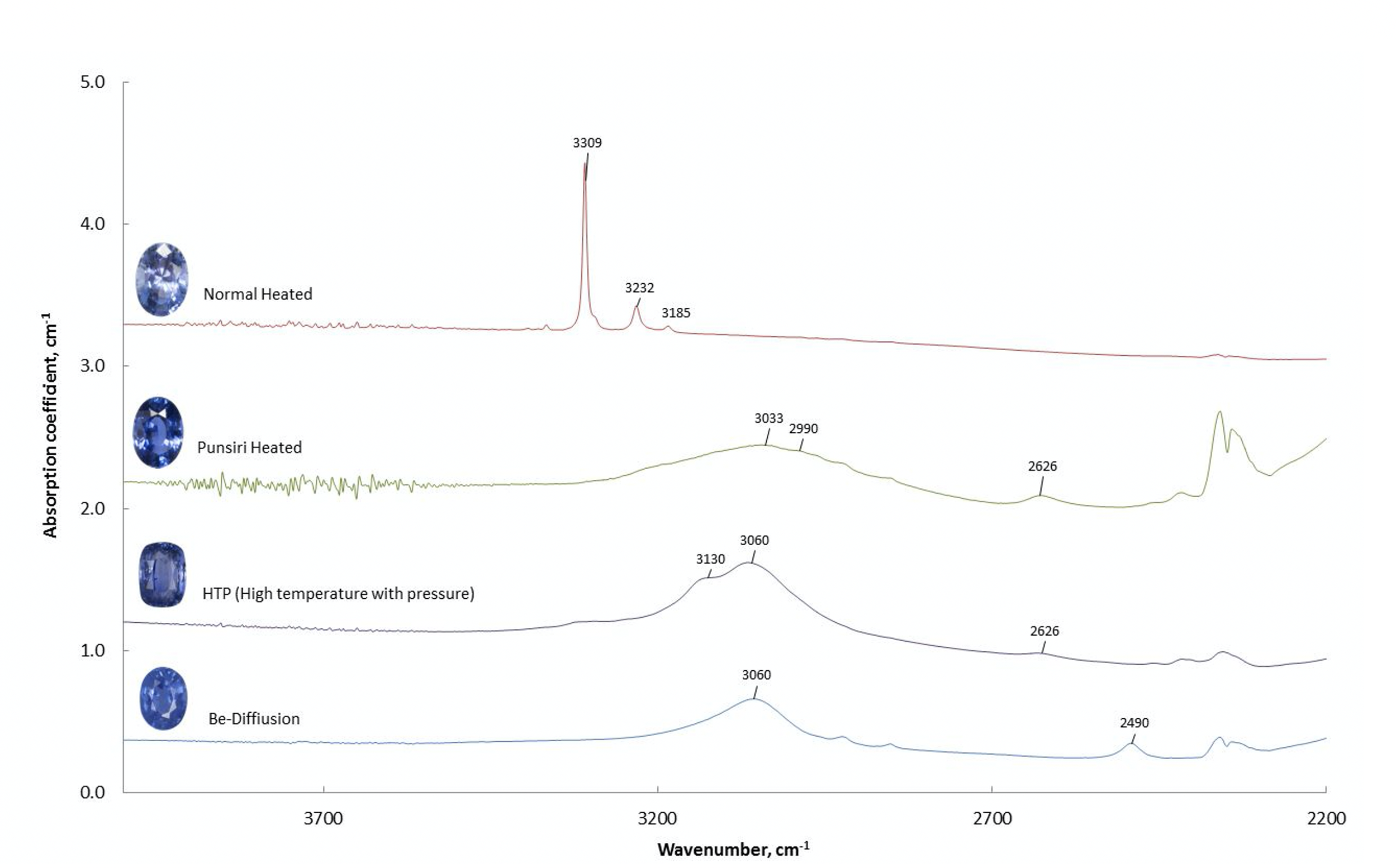
Figure 2
The FTIR spectra observed in sapphires that have been subject to “normal heating”, “Punsiri heating”, High temperature with pressure (HTP), and beryllium (Be) diffusion.

Figure 3
“Normal” heated Blue sapphire, altered healed fissures and white particles. Dark field & fiber optic light, FOV 3.0 mm: Photomicrograph by Sarocha Luetrakulprawat.
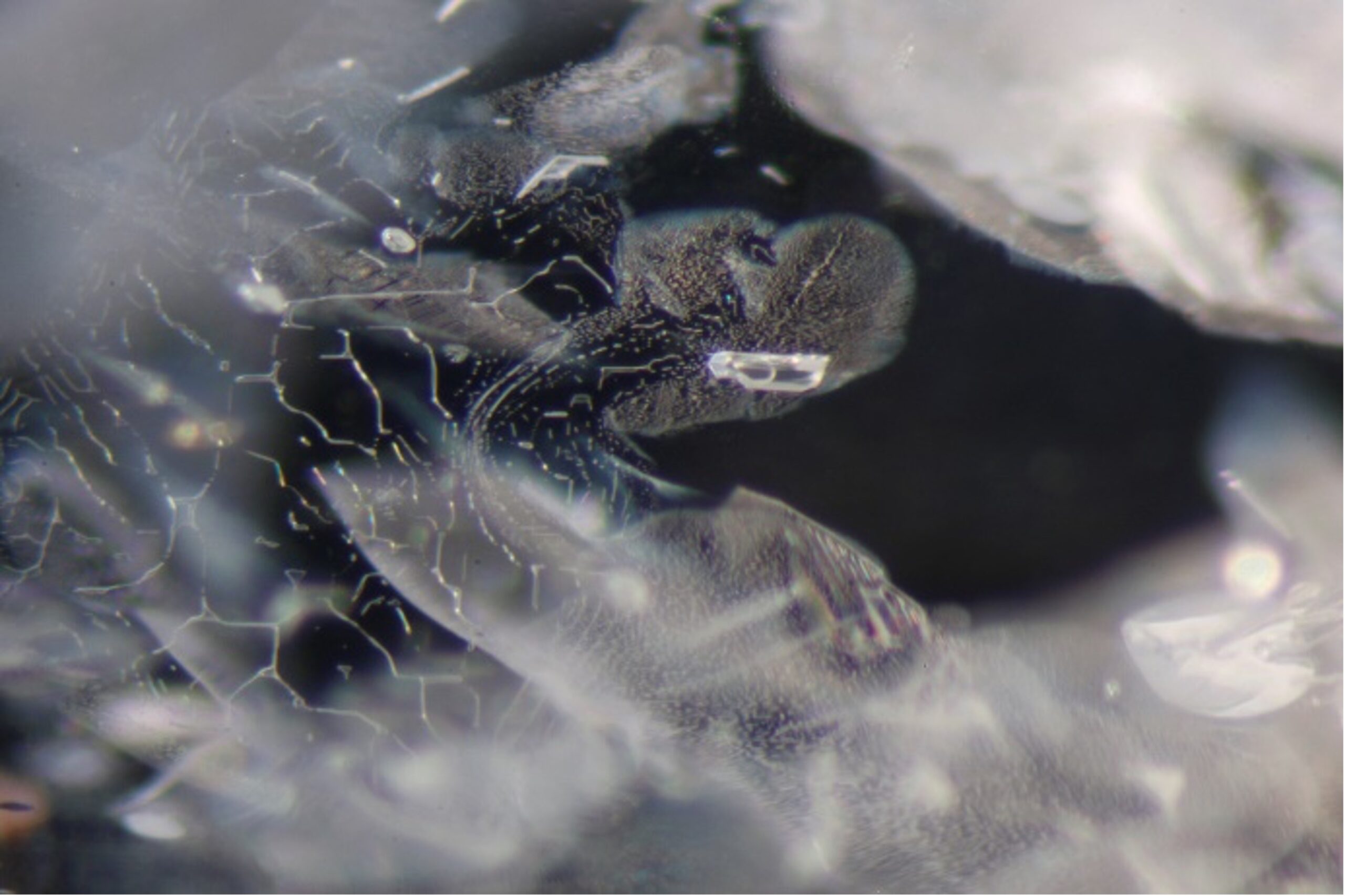
Figure 4
Normal heated Blue sapphire, 2 phase crystal surround with altered healed fissures. Darkfield
& fiber optic light, FOV 3.0 mm: Photomicrograph by Sarocha Luetrakulprawat

Figure 5
“Punsiri heated” blue sapphire, visible with fibre optic lighting present is dissolved silk. Darkfield
& fiber optic light, FOV 2.2 mm: Photomicrograph by Sarocha Luetrakulprawat

Figure 6
HPT treated Blue sapphire, crop circles or spiral formations, fiber optic light, FOV 2.0 mm: Photomicrograph by Yenruedee Lhongsomboon
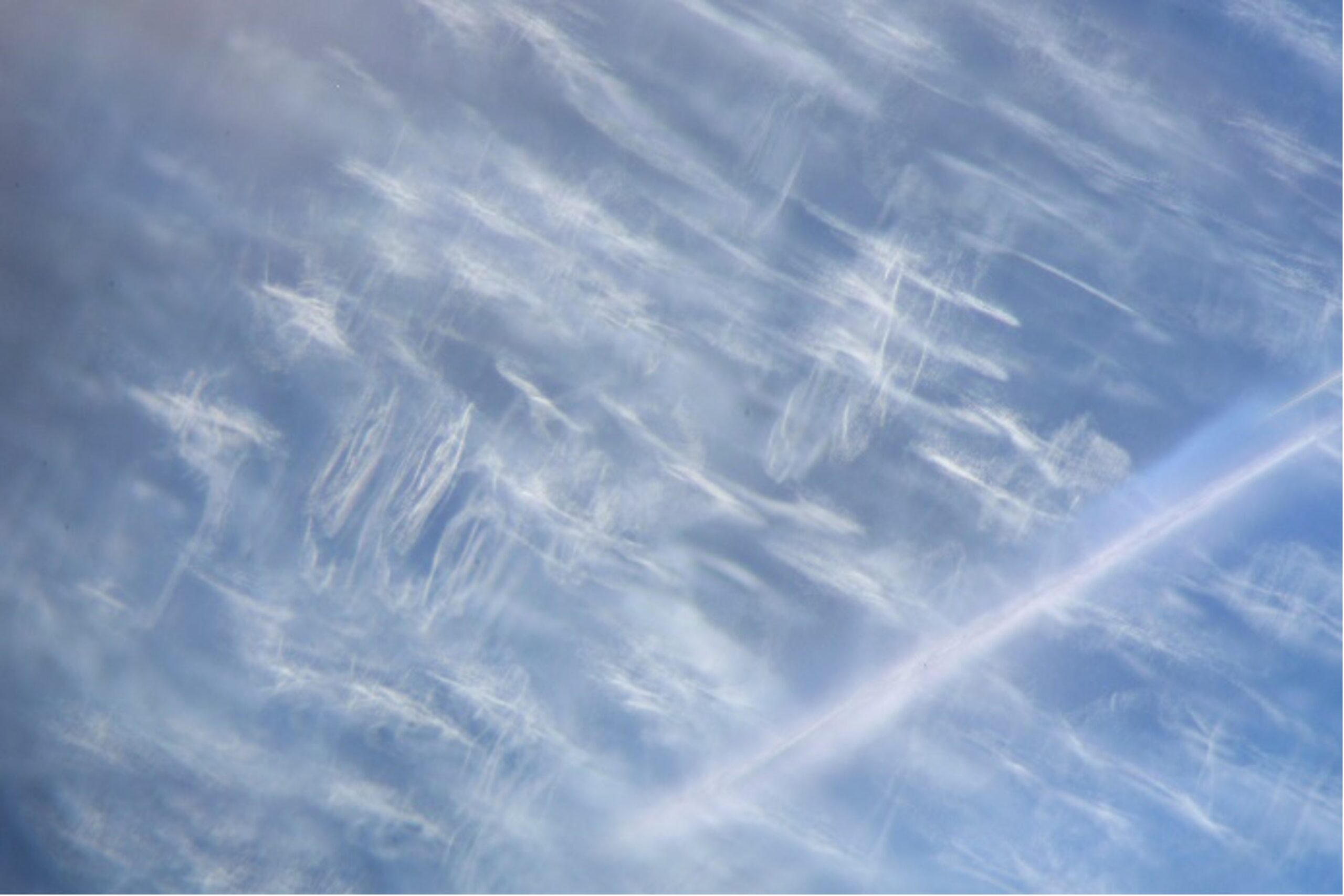
Figure 7
Be diffusion treated blue sapphire, displays clouds and coiled spring-like inclusions, fiber optic light, FOV 3.6 mm: Photomicrograph by Sarocha Luetrakulprawat
About the Writer

Sarocha Luetrakulprawat
Sarocha Luetrakulprawat Sarocha Luetrakulprawat was an Analyst at
ICA IGemLab. She graduated from Burapha University in Chanthaburi, Thailand in Gems and Jewellery at Faculty of Gems. Her responsibility was the identification on gemstones and the operation advanced analytical instrumentation to obtain and analyse the data.
REFERENCES
Abraham, J. S. D., 1982, Heat treating corundum: The Bangkok
operation: Gems and Gemology, v. 18, no. 2, p. 79–82.
Anonymous, 1917, Heat treatment of sapphire: Queensland
Government Mining Journal.
-, 2020a, How can the Jewellery Industry Survive During this Covid-19 Crisis, Volume 2020: https://www.navneetgems.
com/how-can-the-jewellery-industry-survive-during-this-covid-
19-crisis/, Nevneet Gems & Minerals.
-, 2020b, How to Choose a Teal Sapphire Engagement Ring:
https://navneetgems.blogspot.com/2020/05/how-to-chooseteal-
sapphire-engagement.html, Navneet Gems.
-, 2020c, Spinels: Historic Underdogs, Modern Day Marvels:
https://www.navneetgems.com/history-of-burma-wholesale-
spinels/, Navneet Gems & Minerals.
Balmer, W. A., Krzemnicki, M.S., 2015, Be-detection by FTIRon corundum: A preliminary report, 34th IGC: Vilnius, Lithuania.
Champion., K., 2020, 2021 forecast colour palette: Coloured
gems to look for in the new decade, Jewellery, Canada’s
Jewellery Magazine: https://www.jewellerybusiness.com/features/
2021-forecast-colour-palette-coloured-gems-to-look-forin-
the-new-decade/, Jewellery, Canada’s Jewellery Magazine.
Choi H.M., K. S. K. a. K. Y. C., 2014, Appearance of new
treatment method on sapphire using HPHT apparatus., ICGL
Newsletter, Volume 4: http://icglabs.org/wp-content/uploads/
2014/12/ICGLNewsletter-2014FA.pdf, ICGLABS.
DuToit, G., Thanachakaphad, J., Scarratt, K. , 2009, Beryllium
Treated Blue Sapphires: Continuing market observations
and update including the emergence of larger size stones.
June 25th 2009., News from Research: http://www.gia.edu/
research-resources/news-from-research/index.html, GIA.
Emmett, J., Scarratt, K., McClure, S. F., Moses, T., Douthit, T.
R., Hughes, R., Novak, S., Shigley, J. E., Wang, W., Bordelon,
O., and Kane, R. E., 2003, Beryllium diffusion of ruby and
sapphire: Gems and Gemology, v. 39, no. 2, p. 84-135.
Fryer, C., 1983, Corundum, more on heat treatment: Gems
and Gemology, v. 19, no. 4, p. 232.
Kane, R. E., and Liddicoat, R. T., 1985, The Biron hydrothermal
synthetic emerald: Gems and Gemology, v. 21, no. 3, p.
156-170.
Karampelas, S., Alshaybani, B., Mohamed, F., Sangsawong,
S., Al-Alawi, A, 2019, Emeralds from the Most Important Occurrences:
Chemical and Spectroscopic Data. : Minerals.
Koivula, J. I., and Kammerling, R. C., 1991, Montana sapphire
heat treatment: Gems and Gemology, v. 27, no. 3, p. 186-
187.
Krzemnicki, M., Cartier, L., Hughes,R., Leelawatanasuk, T.,
Kiefert, L., Choudhary, G., McClure, S., Milisenda, C., Gambini,
E., Kim, S., Schwarz, D., Dunaigre, C., Horikawa, Y.,
2019, Sapphires Heated with Pressure – A Research Update:
InColor, v. Spring, no. 42.
Kyi, U. H., Buchholz, P., and Wolf, D., 1999, Heat treatment
of milky sapphires from the Mogok stone tract, Myanmar:
Journal of Gemmology, v. 26, no. 5, p. 313-315.
Leelawatanasuk, T., Atsawatanapirom, N., Lhuaamporn, T.,
Ounorn, P., 2016, Blue Sapphire Undergone High Pressure
High Temperature Enhancement, , GIT gemstone update:
https://www.git.or.th/eng/testing_center_en/lab_notes_en/
glab_en/2016/07/BlueSapphire_26072016.pdf., GIT.
Marketwatch, 2020, Sapphire Market 2020 Globa Share,
Size, Future Demant, Global Research, Top Leading Players,
Emerging Trends, Region by Forecast to 2026: https://www.
marketwatch.com/press-release/sapphire-market-2020-global-
share-size-future-demand-global-research-top-leadingplayers-
emerging-trends-region-by-forecast-to-2026-2020-10-
01?tesla=y.
Nassau, K., 1982, Color enhancement of gemstones: Heat
treatment of corundum: International Gemmological Symposium
– Proceedings, p. 111-117.
Pemadasa, T. G., and Danapala, M. V., 1994, Heat treated
corundums of Sri Lanka: Their heat treatment: Australian
Gemmologist, v. 18, no. 11, p. 346-347.
Pough, F. H., 1965, A new hydrothermal synthetic emerald:
Journal of Gemmology, v. 9, no. 12, p. 426-433.
Punsiri, 2003, Sapphire heating conditions in Sri Lanka, in
Scarratt, K., ed.: New York.
Renfro, N., Sun, Z., Nemeth, M., Vertriest, W., Raynaud, V.,
Weeramonkhonlert, V., 2017, A New Discovery of Emeralds
from Ethiopia (Gem News International): Gems & Gemology,
v. 53, no. 1, p. 114-116.
Saeseaw, S., Renfro, N., Palke,A., Sun, Z., McClure, S., 2019,
GEOGRAPHIC ORIGIN DETERMINATION OF EMERALD:
Gems & Gemology, no. Winter, p. 614-646.
Scarratt, K., 1981, Notes from the Laboratory: Heat treated
blue sapphire: Journal of Gemmology, v. 17, no. 8.
-, 1983, Heat treated sapphires: Retail Jeweler, v. 22, no. 543,
p. 16–17.
-, 1985a, Heat treated rubies and sapphires: Journal of Gemmology,
v. 19, no. 8, p. 656-657.
-, 1985b, Notes from the Laboratory: Internal diffusion in
sapphire: Journal of Gemmology, v. 19, no. 8.
-, 1988, Notes from the Laboratory: Inclusions in heated corundum:
Journal of Gemmology, v. 21, no. 3.
Scarratt, K., 2002a, American Gem Trade Association – Orange-
Pink Sapphire Alert, Volume 2002, AGTA.
-, 2002b, Further Characterization of Sapphires Recently
Treated in Bangkok, Volume 2002, AGTA-GTC.
Scarratt, K., 2003, A review of preliminary data on heated
blue sapphires with an unusual color distribution – a work in progress., Gemstone Update: AGTA.Org, AGTA.
Schmetzer, K., Albert Gilg, H., Vaupel, E, 2016, Synthetic Emeralds Grown by Richard Nacken in the Mid-1920s: Properties, Growth Technique, and Historical Account. : Gems & Gemology, v. 52, no. 4, p. 368-392.
Schmetzer, K., Kiefert, L., Bernhardt, H. J., and Beili, Z., 1997, Characterization of Chinese hydrothermal synthetic emerald: Gems and Gemology, v. 33, no. 4, p. 276-291.
Schollenbruch, K., Link, K., Sintayehu, T. , 2017, Gem Quality Emeralds from Southern Ethiopia: InColor., no. 35, p. 48-54.
Shigley, J. E., Chapman, J., and Ellison, R. K., 2001, Discovery and mining of the Argyle diamond deposit, Australia: Gems and Gemology, v. 37, no. 1, p. 26-41.
Themelis, T., 1992, The Heat Treatment of Ruby and Sapphire, No city, Gemlab Inc., 254 pp. p.:
Tombs, G., 1978, Heat treatment of Australian blue sapphires: Australian Gemmologist, v. 13, no. 6, p. 186–188.
Tombs, G. A., 1982, Heat treatment of Australian blue sapphires: Zeitschrift der Deutschen Gemmologischen Gesellschaft, v. 31, no. 1/2, p. 41–48.
Wijesuriya, G., 1985, The technique of heat treatment of geuda to blue sapphire: Journal of the Gemmologists Association of Sri Lanka, no. 2, p. 31–36.
Woetzel, J., Madgavkar, A., Ellingrud, K., Labaye, E., Devillard, S., Kutcher, E., Manyika, J., Dobbs, R., Krishnan, M. , 2015, The Power of Parity: How Advancing Women’s Equaliity Can Add $12 Trillion to Global Growth: https://ideas.repec.org/p/ess/wpaper/id7570.html, Mckinsay Global Institute, p. 168.

